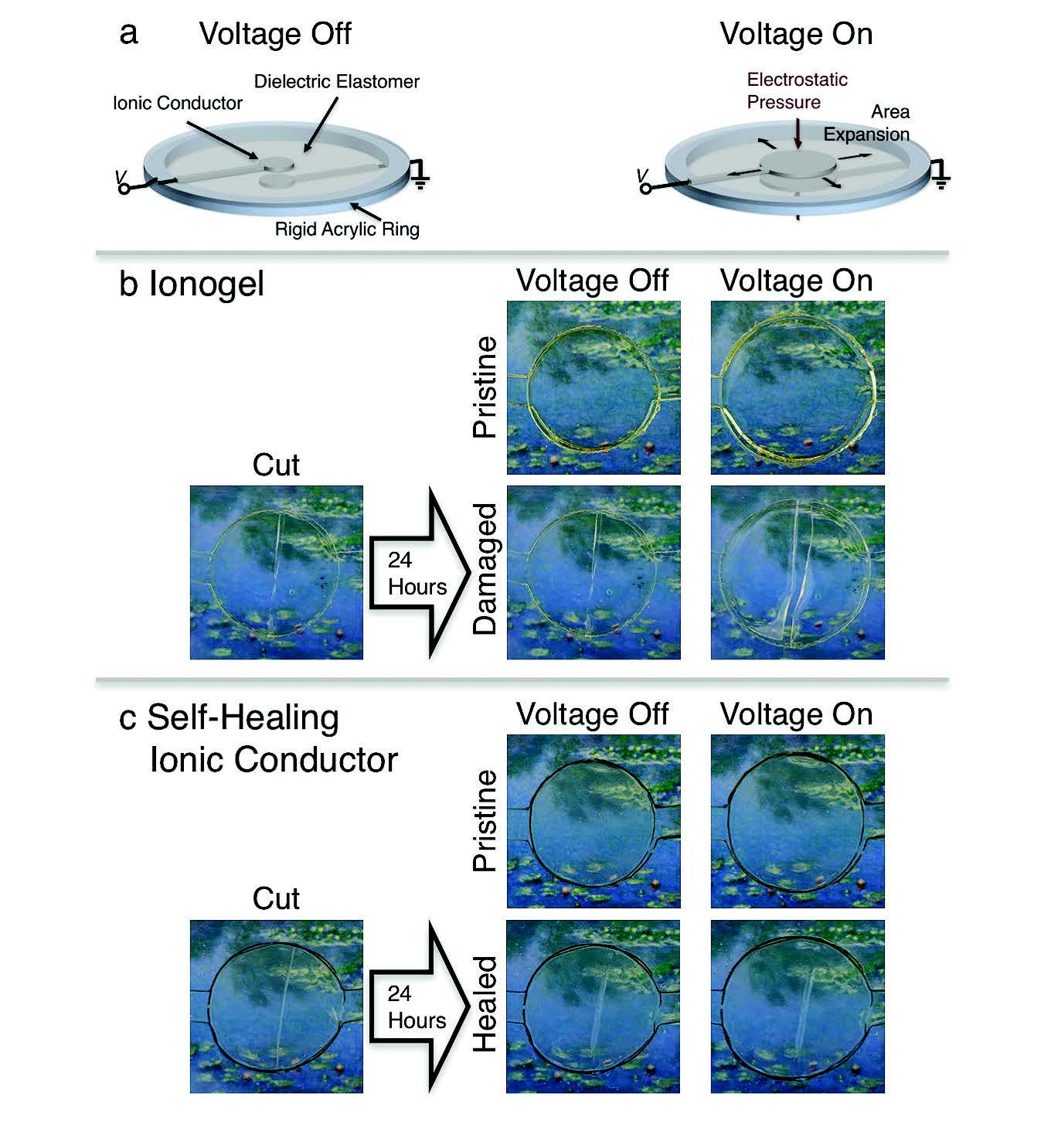Self-healing ionic conductor
Dr. Neil Canter, Contributing Editor | TLT Tech Beat March 2017
Potential applications include repairing wear damage and extending the life of lithium-ion batteries.
KEY CONCEPTS
•
Researchers have developed a stable and effective self-healing ionic conductor based on a polar polymer network and an ionic liquid.
•
The key to the self-healing ionic conductor is the ion-dipole interactions between the cationic component of the ionic liquid and the dipole found in the polar polymer.
•
Self-healing began immediately in experiments after the ionic conductor was cut into two pieces.
THE CONTINUING PUSH to increase the operating life and effectiveness of machinery is leading researchers to look for ways to maintain performance in stressful applications. One concept that continues to be examined is the development of materials that can heal themselves when damaged.
In a past TLT article, a self-healing coating was developed that can be used to protect substrates from corrosion even after the coating is damaged (
1). Monomer and catalyst were encapsulated in separate microcapsules placed in the coating during manufacture. Upon rupture of the coating, the microcapsules opened, releasing their components that produced a self-healing coating. Salt spray corrosion testing showed that this self-healing approach enabled the coating to continue to resist corrosion compared to a control, which showed extensive corrosion.
The concept of self-healing can be used in other applications such as repairing wear damage and extending the life of lithium-ion batteries. To fully utilize the benefits of self-healing, other functionalized materials need to be included.
One such material is an ionic conductor. Chao Wang, adjunct assistant professor of chemistry at the University of California, Riverside in Riverside, Calif., says, “Ionic conductors are materials that facilitate the rapid movement of ions within them. For example, the electrolyte in lithium-ion batteries is an ionic conductor.”
Ionic conductors are finding use in energy storage, solar energy conversion, sensors and electronic device applications. But the stresses that can occur in these applications may damage the ionic conductors limiting reliability and operating life.
Wang says, “The long-term operating problems with lithium-ion batteries are caused in part by dendrites that form during use. Dendrites can form cracks and eventually they also can short-circuit the battery leading to damaging fires. The use of a self-healing material might be able to provide the mechanical flexibility to stop the damaging effects of dendrites.”
But there are a lot of obstacles in the preparation of self-healing ionic conductors, according to Wang. Current self-healing polymers mainly use hydrogen bonds, metal-ligand coordination bonds, electrostatic interactions, etc. Wang says, “These bonds are very limited in this application because of their poor stability in the electrochemical environment.”
A new approach is needed to develop a self-healing ionic conductor that is stable and effective. Such a material now has been developed.
ION-DIPOLE INTERACTIONS
Wang and his colleagues, including Christoph Keplinger, assistant professor of mechanical engineering at the University of Colorado in Boulder, Colo., have developed a self-healing ionic conductor based on a polar polymer network that contains an ionic liquid.
Wang says, “The key to the self-healing ionic conductor is the ion-dipole interactions between the cationic component of the ionic liquid and the dipole found in the polar polymer. This interaction leads to the cross-linking of the polymer chains and enables the material to self-heal.”
The researchers chose a copolymer of vinylidene fluoride and hexafluoropropylene as the polar polymer. An ionic salt based on an imidazolinium cation was used as the ionic salt. Wang says, “Finding the right ionic liquid to create a self-healing ionic conductor that was transparent and stretchable proved to be challenging. We found that a specific imidazolinium derivative (1-ethyl-3-methylimidazolinum) combined with a particular anion (trifluoromethanesulfonate) proved to work well.”
The weight ratio of the polar polymer to the ionic salt also is important in optimizing the performance of the self-healing ionic conductor. Wang says, “The stretchability or elasticity of the material reaches a maximum at an ionic liquid weight percentage of 48%. When this figure is exceeded, the material is not as elastic.”
Self-healing capabilities were evaluated by cutting a sample into two distinct pieces with a razor blade and then gently bringing the two pieces back into contact with each other. The degree of healing was determined through measurement of the material’s mechanical properties. A self-healing ionic conductor containing 43% of the ionic salt saw a restoration of its mechanical properties within 24 hours of being cut.
The researchers also noted that self-healing began immediately once the two pieces of the material were put in contact with each other. After only five minutes, the material can be stretched to twice its original length.
One of the potential applications for the self-healing ionic conductor is in electrically activated dielectric elastomer actuators (DEAs), also known as artificial muscles. The researchers electrically evaluated DEAs containing a stack of three polymers by applying a voltage. The stretchable conductor was in the top and bottom layer while a non-conducting rubber-like membrane is in the middle layer. A schematic of the DEA is shown in the top section of Figure 1 at rest and when the voltage has been turned on.
 Figure 1. A self-healing ionic conductor has been developed for use in applications such as electrically activate dielectric actuators. In comparison testing, the ionogel used as a stretchable conductor did not self-heal within 24 hours after being cut as shown in the middle section. The self-healing ionic conductor healed within 24 hours after being cut as shown in the bottom section. (Figure courtesy of the University of California, Riverside.)
Figure 1. A self-healing ionic conductor has been developed for use in applications such as electrically activate dielectric actuators. In comparison testing, the ionogel used as a stretchable conductor did not self-heal within 24 hours after being cut as shown in the middle section. The self-healing ionic conductor healed within 24 hours after being cut as shown in the bottom section. (Figure courtesy of the University of California, Riverside.)
The researchers prepared two identical DEAs with one using an ionogel as the stretchable conductor and the other using the self-healing ionic conductor. In the middle section of Figure 1, the ionogel based DEA did not self-heal 24 hours after being cut. In contrast, the self-healing ionic conductor shown in the bottom section of Figure 1 healed after 24 hours.
Currently the researchers are working to maximize the performance characteristics of the self-healing polymer. Wang says, “We are working to improve the ion conductivity and mechanical strength of this material. Our objective is to evaluate the self-healing ionic conductor in self-healing devices.”
Additional information on this research can be found in a recent paper (
2) or by contacting Wang at
chaowang@ucr.edu.
REFERENCES
1.
Canter, N. (2009), “Coating: Heal thyself,” TLT,
65 (6), pp. 16-17.
2.
Cao, Y., Morrissey, T., Acome, E., Allec, S., Wong, B., Keplinger, C. and Wang, C. (2016), “
Advanced Materials,” DOI: 10.1002/adma.201605099.
 Neil Canter heads his own consulting company, Chemical Solutions, in Willow Grove, Pa. Ideas for Tech Beat can be submitted to him at neilcanter@comcast.net
Neil Canter heads his own consulting company, Chemical Solutions, in Willow Grove, Pa. Ideas for Tech Beat can be submitted to him at neilcanter@comcast.net.